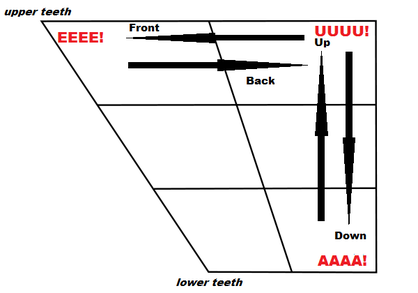Vowel Awareness
Vowels are created by completely opening the vocal tract and allowing air to flow out unobstructed. What determines the sound of a vowel is the position of your tongue within your mouth. To help in this process, you will first develop a physical awareness of your tongue's location in your mouth.
Vowel Height
|
|
You should have noticed that your tongue and lower jaw have to move all the way down to create the "AAAA!" sound. Since this movement opens up the oral cavity more, we define this vowel sound as OPEN. On the other end, the tongue has to move almost all the way UP until it almost completely blocks the oral cavity to create the "UUUU!" sound. For this reason, we define this vowel sound as CLOSED.
Vowel Backness
|
|
You should have noticed that your tongue must move forward toward your teeth to make the "EEEE!" sound; we define this vowel sound as a FRONT vowel. To go back to the "UUUU!" sound, you have to retract your tongue back deeper into your mouth. As such, we define this vowel sound as a BACK vowel.
Visualizing Vowel Tuning
|
The chart to the right is known as a "Vowel Chart." A vowel chart visually plots the location of a vowel within your mouth.
The three vowel sounds on this page are the extremes in Vowel Height and Backness. In other words, the other vowel sounds for a given language are going to occur at some point between these three extremes. You will rely mostly on your ear to do this, but I can help you a great deal by starting you on the nearest English vowel and pointing you in the right direction from there. For this to work, you need to develop a sense of direction. |
|
|
|
Later on in this course, as you advance through the song lessons and submit audio recordings of yourself, this is the kind of feedback you'll get. When you think you are comfortable with everything on this page, move on to the next one to start "tuning" your Spanish vowels.


